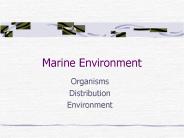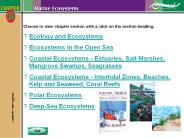Marine Phytoplankton PowerPoint PPT Presentations
All Time
Recommended
Marine phytoplankton powder is one of the most nutrient dense plants in the world with high levels of Chlorophyll (type A), Antioxidants, Beta Carotene, and Zeaxanthin.
| PowerPoint PPT presentation | free to download
With Marine Phytoplankton
| PowerPoint PPT presentation | free to view
Abundant and large deep-ocean benthos. Discovered in 1977. Associated with hot vents ... Marine versus freshwater fish. Fig. 12.14. Adaptations to marine life ...
| PowerPoint PPT presentation | free to view
Responses of Marine Phytoplankton Blooming to Environmental Changes
| PowerPoint PPT presentation | free to view
How marine data can be presented at a global scale: The AFRICAN MARINE ATLAS as a case study
| PowerPoint PPT presentation | free to view
Optical measurements of phytoplankton size and volume concentration (LISST-100X): Applications and limitations Lee Karp-Boss, Laura Azevedo and Emmanuel Boss
| PowerPoint PPT presentation | free to download
Pfisteria, their blooms can cause red tides Phytoplankton! Ayesha, Toyosi, Chase Diatoms have many different shapes Phytoplankton Autotrophic/ photosynthetic plant ...
| PowerPoint PPT presentation | free to download
Marine Environment Organisms Distribution Environment Life in the Ocean Plankton: floaters Nekton: swimmers Benthos: bottom dwellers Phytoplankton Carry on ...
| PowerPoint PPT presentation | free to download
Marine Environment Organisms Distribution Environment Life in the Ocean Plankton: floaters Nekton: swimmers Benthos: bottom dwellers Phytoplankton Carry on ...
| PowerPoint PPT presentation | free to download
Marine Pollution
| PowerPoint PPT presentation | free to download
Chapter 9 Marine Ecology Chapter 9 Marine Ecology Bathypelagic Deep water where it is completely dark Abyssopelagic Water near the sea floor Hadopelagic Water in deep ...
| PowerPoint PPT presentation | free to view
The marine flora, fauna and climatic conditions
| PowerPoint PPT presentation | free to download
Marine Ecology Prepared by: Dr. Hanan M Mitwally Associate professor Marine Biology Oceanography Department Faculty of Science
| PowerPoint PPT presentation | free to view
Marine Ecosystems Biology The Divisions of the Ocean The ocean can separate the shore, littoral zone, from the open, or pelagic zone, from the ocean floor, benthic zone.
| PowerPoint PPT presentation | free to view
(feeding) Sea lillies ancient group, stalked, common in deep water Phylum Chordata Subphylum Urochordata (G. tail string) Fig. 7.26 Ex. Sea squirts, ...
| PowerPoint PPT presentation | free to download
Nitrogen Cycle In a similar fashion, ... Times New Roman Arial Default Design Slide 1 Introduction Organization Adaptation to differing light regimes.
| PowerPoint PPT presentation | free to view
shallow and near a terrigenous source. the deep ocean basin ... years, sea level lowered by glaciation controls sedimentation and cause rivers ...
| PowerPoint PPT presentation | free to view
Phytoplankton and Zooplankton Phytoplankton The most important organisms on the planet are Phytoplankton Generate 50% of the oxygen that we breath.
| PowerPoint PPT presentation | free to view
Blooms occur in both fresh and salt water. Some blooms give off mild toxins ... Florida red tide Gymnodinium breve, or G. breve was reclassified in the taxonomy ...
| PowerPoint PPT presentation | free to view
Marine Plants Producers Chapter 14
| PowerPoint PPT presentation | free to view
Definition: 'Culture of marine aquatic organisms including ... Koi carp. 5.5 7.4. 8. Marron crayfish. 0.18. 9. Largemouth Bass. 0.3. 15. Mullet. 0.1. 2.7 ...
| PowerPoint PPT presentation | free to download
... Marine vertebrates control internal salt and water concentration by osmoregulation http://marinebio.org/oceans ... ABIOTIC and BIOTIC ... parts of oceans ...
| PowerPoint PPT presentation | free to view
... and beluga whales Great White sharks eat dolphins, sharks, whales, sea lions, sea turtles and sea birds Bull sharks eat dolphins, rays, ...
| PowerPoint PPT presentation | free to view
Marine Ecosystems Marine ecosystems are located mainly in coastal areas and in the open ocean. Organisms that live in coastal areas adapt to changes in water level ...
| PowerPoint PPT presentation | free to download
Estuaries Estuary: a region where a freshwater source, usually the mouth of a river, ... It is thought of as one large biome with many ecosystems and habitats.
| PowerPoint PPT presentation | free to view
Ecology and Ecosystems Ecosystems in the Open Sea Coastal Ecosystems - Estuaries, Salt Marshes, Mangrove Swamps, Seagrasses Coastal Ecosystems - Intertidal Zones ...
| PowerPoint PPT presentation | free to download
... Tilapia-shrimp-halophytes Eritrea Shrimp / tilapia ponds Mangroves Salicornia Salicornia Mangroves Shrimp-fish systems Tilapia cages in shrimp pond, ...
| PowerPoint PPT presentation | free to download
Ecology and Ecosystems Ecosystems in the Open Sea Coastal Ecosystems - Estuaries, Salt Marshes, Mangrove Swamps, Seagrasses Coastal Ecosystems - Intertidal Zones ...
| PowerPoint PPT presentation | free to download
Nutrient Cycles in Marine Ecosystems ...
| PowerPoint PPT presentation | free to download
Diatoms are most dominant and abundant photosynthesizer in ... This is a pennate (elongated) diatom. It is about 15 m long. Diatom Reproduction. Dinoflagellates ...
| PowerPoint PPT presentation | free to view
Photosynthesis and chemosynthesis as means of energy capture Productivity and energy flow along food chains
| PowerPoint PPT presentation | free to download
It is the study of how organisms adapt to their environment and in turn alter it. ... Dinoflagellates are single cells with two whip-like tails (flagella). 9-5 ...
| PowerPoint PPT presentation | free to view
Climate, Oceans and Phytoplankton:
| PowerPoint PPT presentation | free to download
* What are the garbage patches ? The garbage patch, as referred to in the media, is an area of marine debris concentration in the North Pacific Ocean.
| PowerPoint PPT presentation | free to view
Autotrophic Bacteria. Chemosynthetic Bacteria. Cyanobacteria ... Can be autotrophic, heterotrophic, or mixotrophic. Some have a test known as a theca ...
| PowerPoint PPT presentation | free to view
Secchi Disk Used to estimate the transparency of seawater, and can provide a relative measure of productivity or turbidity. Drift bottles The use of drift bottles ...
| PowerPoint PPT presentation | free to download
Phytoplankton and Primary Productivity. Introduction to Biological ... Approaches to the measurement of plankton production. ( 78-108). Both in: In, P.J. LeB. ...
| PowerPoint PPT presentation | free to download
One of the most intensely studied topic in marine geology is the early ... Availability of nitrate as an oxidant is limited since it is an important ...
| PowerPoint PPT presentation | free to view
Marine softsediment communities
| PowerPoint PPT presentation | free to view
Mangroves can tolerate really tough conditions, including salt water, but they ... The multicellular algae (aka seaweeds) are divided into 3 ... Sea lettuce ...
| PowerPoint PPT presentation | free to view
Marine Ecology Prepared by: Dr. Hanan M Mitwally Associate professor Marine Biology Oceanography Department Faculty of Science
| PowerPoint PPT presentation | free to view
Title: Importance of Photochemical Processes in the Sea Last modified by: Dave Siegel Created Date: 9/30/1996 6:28:10 PM Document presentation format
| PowerPoint PPT presentation | free to view
Marine Aerosols, Clouds and Climate
| PowerPoint PPT presentation | free to view
Algae / phytoplankton Plant (Producer) Get Energy from: the sun; make their own food through photosynthesis. Place in Food Web: (Producer) form the basis of the ...
| PowerPoint PPT presentation | free to download
Environmental Issues for the Marine Biome Essential Questions How are humans impacting the marine biome? What is our role in protecting the marine biome?
| PowerPoint PPT presentation | free to download
By Jeany Shin & Jessica Yoo Introduction The marine biome is the largest biome on Earth. It covers about 70% of the Earth s surface. It is home to some of the ...
| PowerPoint PPT presentation | free to view
Ocean color remote sensing of phytoplankton physiology & primary production Toby K. Westberry1, Mike J. Behrenfeld1 Emmanuel Boss2, David A. Siegel3
| PowerPoint PPT presentation | free to download
cyanobacteria fix nitrogen- essential for eukaryotic ... all contribute to Biogenous ooze. Eukaryotic. Diatoms. Eukaryotic. Dinoflagellates. Eukaryotic ...
| PowerPoint PPT presentation | free to view
Application of pigment analysis and CHEMTAX to field studies of phytoplankton communities Simon Wright Australian Antarctic Division Outline Phytoplankton community ...
| PowerPoint PPT presentation | free to view
Chapter 13: The Marine Habitat Most organisms live in euphotic zone Sunlight Nutrients Marine algae Other organisms need algae Directly or indirectly Classification ...
| PowerPoint PPT presentation | free to download
Krill as a major vector for Domoic acid. Pseudo-nitzschia in Monterey Bay, CA ... Krill: a potential vector for Domoic acid in marine food webs. ...
| PowerPoint PPT presentation | free to download
A complex ecosystem Producers turn the sun s energy into usable energy for consumers. Consumers will feed on producers or other consumers for energy Decomposers ...
| PowerPoint PPT presentation | free to view
... CLASSIFICATIONAND TAXONOMY. General ... AND TAXONOMY. Bacillariophyta (Diatoms) ... ALGAL CLASSIFICATION AND TAXONOMY. Chrysophyta. yellow green or ...
| PowerPoint PPT presentation | free to view
International Journal of Marine Science and Ocean Technology (IJMO) is a peer-reviewed, open access journal, devoted to the publication of visions that contribute to our scientific understanding of marine systems and critical reviews in regard to the impact of human activities on them. IJMO provides a forum to discuss in regard to the current issues in marine science and ocean technology by publishing original, full-length and research articles in this field. IJMO publishes high quality papers, original papers, research letters and case reports.
| PowerPoint PPT presentation | free to download
They can be divided into phytoplankton (plants) and zooplankton (animals) ... Zooplankton include the copepods and foraminifera. ...
| PowerPoint PPT presentation | free to view
























































